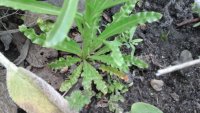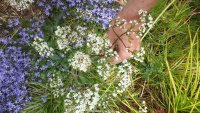zozo
Member
I bought some hemp agrimony seeds
I guess that's correct, it's an Agrimonia sp. 🙂
The other one looks like a young Peper plant.
Ah!? cross-posted with Darrel, didn't know there was a different Hemp agrimony...
I bought some hemp agrimony seeds



didn't know there was a different Hemp agrimony...
That one is Weld or Dyer's Rocket (Reseda luteola). It is a biennial, but will seed into gravel paths etc. It likes bare limy ground, so you get it wild on the downs etc., but away from that it is nearly always a "weed" of limestone gravel, so along railway lines, on car parks etc.So guess I have another Id for you
Yes, Hemp Agrimony likes wet, or bare ground, it is a very good grower, so you may need to weed a bit out every year.It makes a great pond plant
It is the most incredible self seeder, you can see it in the background of the pond photo, but it enjoyed itself in the gravel garden and borders as well. I've probably pulled out fifty seedlings this year and it also spreads by runners.Didn't realise it was as potentially rampant as that.

It does look like an umbellifer, but very slightly pinky and little tubular flowers when you look closely. It might be a humidity issue, it is really common in W. Ireland and grows in a lot of the fields. Locally I've only ever seen it in wet places.I do have a couple of white umbellifers that popped up this year that I think are probably them but I never really thought about it until now.
I'm a great fan of the self seeders as well, I like "light editing" as a concept.I don't mind stuff that self seeds a plenty, I'd like to get to the stage where I don't need to do anything apart from some light editing.


Both definitely Valeriana officinalis.Not sure if it's possible to ID
I've heard plenty, but I've never seen one.We even saw a couple of cetti warblers
if those leaves are paired , I'm convinced it's some sort of Fuchsia, looks like the top has been killed by frost or knocked off, hence the side shootsAnybody an idea what this sneaking might be? It has a wooden stem and it seems to be some kinda climbing shrub...
View attachment 167936
I have a plant ID app on the phone, but it only suggests herb-like plants that do not have a wooden stem.
🙂
if those leaves are paired , I'm convinced it's some sort of Fuchsia, looks like the top has been killed by frost or knocked off, hence the side shoots
Willow (Salix sp.)? The photo is slightly out of focus.Anybody an idea what this sneaking might be?
They are, but that definitely has alternate shoots (and buds), so I'm pretty sure it isn't a Fuchsia.leaves on Fuchsia are either arranged in opposite pairs or opposite trios depending on the cultivar
I was wondering about that one.That naked stem next to it is not from the same plant, that's a Walnut.
I never would have thought of that But looking up some pictures I can see some resemblance, a young weeping willow maybe? ... 🙂 I'll see I get a better picture tomorrow.Willow (Salix sp.)? The photo is slightly out of focus.
I'm still in doubt if it survived that severe sudden winter shock last winter in this pot, it's 1 or 2 years old maybe. The stem still looks sappy, but yet didn't see new leave growth. I think this is a tad too late? I don't really know when it first sprouted, i regularly find wall-nuts in my garden under the chestnut tree. I guess squirrels or maybe birds like crows have dropped them.I was wondering about that one.

